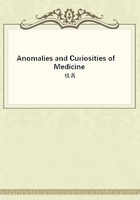
第26章
There is an instance recorded of the death of a fetus occurring near term, its retention and subsequent discharge being through a spontaneous opening in the abdominal wall one or two months after.
Meigs cites the case of a woman who dated her pregnancy from March, 1848, and which proceeded normally for nine months, but no labor supervened at this time and the menses reappeared. In March, 1849, she passed a few fetal bones by the rectum, and in May, 1855, she died. At the necropsy the uterus was found to contain the remains of a fully developed fetus, minus the portions discharged through a fistulous connection between the uterine cavity and the rectum. In this case there had been retention of a fully developed fetus for nine years. Cox describes the case of a woman who was pregnant seven months, and who was seized with convulsions; the supposed labor-pains passed off, and after death the fetus was found in the womb, having lain there for five years. She had an early return of the menses, and these recurred regularly for four years. Dewees quotes two cases, in one of which the child was carried twenty months in the uterus; in the other, the mother was still living two years and five months after fecundation. Another case was in a woman of sixty, who had conceived at twenty-six, and whose fetus was found, partly ossified, in the uterus after death.
There are many narratives of the long continuation of fetal movements, and during recent years, in the Southern States, there was quite a prevalence of this kind of imposters. Many instances of the exhibition of fetal movements in the bellies of old negro women have been noticed by the lay journals, but investigation proves them to have been nothing more than an exceptional control over the abdominal muscles, with the ability to simulate at will the supposed fetal jerks. One old woman went so far as to show the fetus dancing to the music of a banjo with rhythmical movements. Such imposters flourished best in the regions given to "voodooism." We can readily believe how easy the deception might be when we recall the exact simulation of the fetal movements in instances of pseudocyesis.
The extraordinary diversity of reports concerning the duration of pregnancy has made this a much mooted question. Many opinions relative to the longest and shortest period of pregnancy, associated with viability of the issue, have been expressed by authors on medical jurisprudence. There is perhaps no information more unsatisfactory or uncertain. Mistakes are so easily made in the date of the occurrence of pregnancy, or in the date of conception, that in the remarkable cases we can hardly accept the propositions as worthy evidence unless associated with other and more convincing facts, such as the appearance and stage of development of the fetus, or circumstances making conception impossible before or after the time mentioned, etc. It will be our endeavor to cite the more seemingly reliable instances of the anomalies of the time or duration of pregnancy reported in reputable periodicals or books.
Short Pregnancies.--Hasenet speaks of the possibility of a living birth at four months; Capuron relates the instance of Fortunio Liceti, who was said to have been born at the end of four and a half months and lived to complete his twenty-fourth year. In the case of the Marechal de Richelieu, the Parliament of Paris decreed that an infant of five months possessed that capability of living the ordinary period of existence, i.e., the "viabilite," which the law of France requires for the establishment of inheritance. In his seventh book Pliny gives examples of men who were born out of time. Jonston gives instances of births at five, six, seven, and eight months. Bonnar quotes 5 living births before the one hundred and fiftieth day; 1of one hundred and twenty-five days; 1 of one hundred and twenty days; 1 of one hundred and thirty-three days, surviving to twenty-one months; and 1 of one hundred and thirty-five days'
pregnancy surviving to eighty years. Maisonneuve describes a case in which abortion took place at four and a half months; he found the fetus in its membranes two hours after delivery, and, on laying the membranes open, saw that it was living. He applied warmth, and partly succeeded in restoring it; for a few minutes respiratory movements were performed regularly, but it died in six hours. Taylor quotes Carter concerning the case of a fetus of five months which cried directly after it was born, and in the half hour it lived it tried frequently to breathe. He also quotes Davies, mentioning an instance of a fetus of five months, which lived twelve hours, weighing 2 pounds, and measuring 12 inches, and which cried vigorously. The pupillary membrane was entire, the testes had not descended, and the head was well covered with hair. Usher speaks of a woman who in 1876 was delivered of 2 male children on the one hundred and thirty-ninth day; both lived for an hour; the first weighed 10 ounces 6 drams and measured 9 3/4inches; the other 10 ounces 7 drams, with the same length as the first. Routh speaks of a Mrs. F----, aged thirty-eight, who had borne 9 children and had had 3 miscarriages, the last conception terminating as such. Her husband was away, and returned October 9, 1869. She did not again see her husband until the 3d or 4th of January. The date of quickening was not observed, and the child was born June 8, 1870. During gestation she was much frightened by a rat. The child was weak, the testes undescended, and it lived but eighteen days, dying of symptoms of atrophy. The parents were poor, of excellent character, and although, according to the evidence, this pregnancy lasted but twenty-two weeks and two days, there was absolutely no reason to suspect infidelity.